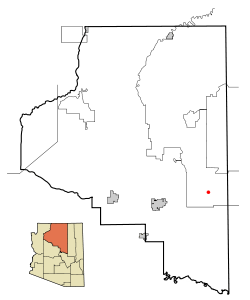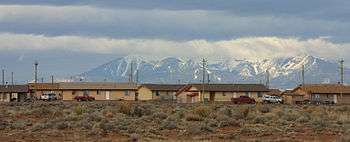Leupp, Arizona
| Leupp, Arizona | |
|---|---|
| CDP | |
|
Leupp, looking west to the San Francisco Peaks | |
 Location in Coconino County and the state of Arizona | |
 Leupp, Arizona Location in the United States | |
| Coordinates: 35°17′51″N 111°0′20″W / 35.29750°N 111.00556°WCoordinates: 35°17′51″N 111°0′20″W / 35.29750°N 111.00556°W | |
| Country | United States |
| State | Arizona |
| County | Coconino |
| Area | |
| • Total | 13.6 sq mi (35.1 km2) |
| • Land | 13.6 sq mi (35.1 km2) |
| • Water | 0.0 sq mi (0.0 km2) |
| Elevation | 4,763 ft (1,452 m) |
| Population (2010) | |
| • Total | 951 |
| • Density | 70/sq mi (27/km2) |
| Time zone | MST (UTC-7) |
| ZIP code | 86035 |
| Area code | 928 |
| FIPS code | 04-40630 |
| GNIS feature ID | 0024010 |
Leupp (Navajo: Tsiizizii) is a census-designated place (CDP) in Coconino County, Arizona, United States. The population was 951 at the 2010 census.[1]
History
The Bureau of Indian Affairs established a school in Leupp in 1902. The town's name is pronounced LOOP. Soon afterward, the school was moved to a new location known as Old Leupp. Old Leupp is a few miles to the southeast of Leupp. Later in 1907, Leupp became the headquarters of the Leupp Indian Land. It was one of five Navajo Indian Lands that existed before 1936.[2]
Navajo Code Talkers
In 1942, Philip Johnston, who was raised 12 miles North of Leupp as a young boy, proposed the idea of having the Navajo language be used as a code in World War II against the Japanese. The code which was unbreakable until the US government released the top secret files, helped U.S in the war. Its significances is that the Navajo language is so complex with its dialect and sentence structure that it would take 2 1/2 minutes to successfully translate and transmit and then re-translate the message, which would take hours for a regular soldier to complete. Had it not been for the surrounding communities like Leupp and Flagstaff, Johnson probably would have never been here to interact with the Navajo people and learn the language. Therefore, the Navajo code talkers would not have existed and would not be there to help US win the war.
Leupp Isolation Center
During World War II, an abandoned Bureau of Indian Affairs boarding school in Leupp was used as the Leupp Isolation Center, for Japanese American internees considered to be "troublemakers" by camp authorities.[3] The first inmates were transferred from Manzanar by way of Leupp's predecessor, the Moab Isolation Center. After a December 1942 clash between camp guards and several hundred Japanese American internees, in which two prisoners were killed, nine prisoners and one guard injured, the 16 men who had instigated the protests were removed from camp and placed in surrounding town jails. While they waited in jail (without being charged with a crime or allowed a hearing) War Relocation Authority officials converted a former Civilian Conservation Corps camp outside Moab, Utah into a temporary isolation center for "noncompliant" Japanese Americans. The 16 men from Manzanar arrived in Moab on January 11, 1943. Over the next three months, another 25 "troublemakers" — mostly men who had resisted the WRA's attempts to assess the loyalty of incarcerated Japanese Americans — were brought to Moab, and on April 27 most of the population was transferred to Leupp. (Five men, serving sentences in the nearby county jail after protesting conditions in the isolation center, were transported to Leupp in a five-by-six-foot box on the back of a truck. Their separate transportation was arranged by Moab director Francis Frederick, who had also handed down their sentences for "unlawful assembly.")[4]
The 49 transfers from Moab were eventually joined in Leupp by additional internees from Tule Lake, Topaz and other camps. Leupp housed a population of approximately 50-60 prisoners at a time, with a total of 80 Japanese Americans passing through the isolation center while it was in operation. The 52 inmates then residing in Leupp were transferred to the stockade at Tule Lake (converted to a segregation center for "disloyal" Japanese Americans earlier that year) on December 2, 1943. The camp technically remained open, retained with minimal maintenance, until September 20, 1944, when the site was returned to Department of the Interior authority.[4]
Leupp Trading Post
In 1910, Mr. John Walker built the Leupp Trading Post out of quarried sandstone at the newly established community now called "Old Leupp", when the BIA began building its agency there. By 1912, Mr Walker sold the post to an unknown party.
<img>http://jan.ucc.nau.edu/~ll3/beauty/thematic units/slb23/images/old leupp store 1.jpg</img>
Stanton K. Borum and Ida Mae Borum became owners of the Leupp Trading Post in 1929, and made an addition to the original structure, thus, a two-story trading post was erected with the Trading Post on the ground floor and the residence on the second floor. William E. and Lucile McGee, who had been in the trading post business since 1923, purchased Leupp Trading Post in 1944 from Ida Mae Borum. After William and Lucile retired in 1968 their son, Ralph and his wife, Ellen, ran the Leupp Trading Post until 1982.
<img>http://www.cr.nps.gov/history/online_books/anthropology74/images/figure14.11.jpg</img>
[6] Winslow section, pgs 47 & 66.
Today, the Leupp Trading Post is defunct, the building dismantled, with nothing remaining other than the foundation.[7]
Geography
Leupp is located at 35°17′51″N 111°0′20″W / 35.29750°N 111.00556°W (35.297522, -111.005673).[8]
According to the United States Census Bureau, the CDP has a total area of 13.6 square miles (35.1 km2), of which 0.01 square miles (0.02 km2), or 0.05%, is water.
Climate
According to the Köppen Climate Classification system, Leupp has a semi-arid climate, abbreviated "BSk" on climate maps.[9]
Demographics
As of the census[10] of 2000, there were 970 people, 228 households, and 206 families residing in the CDP. The population density was 73.9 people per square mile (28.5/km²). There were 277 housing units at an average density of 21.1/sq mi (8.2/km²). The racial makeup of the CDP was 98.14% Native American, 0.62% White, 0.10% from other races, and 1.13% from two or more races. 1.03% of the population were Hispanic or Latino of any race.
There were 228 households out of which 54.8% had children under the age of 18 living with them, 57.9% were married couples living together, 29.8% had a female householder with no husband present, and 9.6% were non-families. 9.2% of all households were made up of individuals and 0.9% had someone living alone who was 65 years of age or older. The average household size was 4.25 and the average family size was 4.53.
In the CDP the age distribution of the population shows 43.7% under the age of 18, 8.8% from 18 to 24, 25.7% from 25 to 44, 17.2% from 45 to 64, and 4.6% who were 65 years of age or older. The median age was 23 years. For every 100 females there were 92.8 males. For every 100 females age 18 and over, there were 85.1 males.
The median income for a household in the CDP was $21,458, and the median income for a family was $29,219. Males had a median income of $28,661 versus $24,531 for females. The per capita income for the CDP was $8,137. About 29.4% of families and 33.4% of the population were below the poverty line, including 45.0% of those under age 18 and 43.1% of those age 65 or over.
Education
Leupp is zoned to schools in the Flagstaff Unified School District which offers a Preschool to 8th grade curriculum.
There is also a B.I.A. Boarding school named Leupp Schools, Inc.
References
- ↑ "Profile of General Population and Housing Characteristics: 2010 Demographic Profile Data (DP-1): Leupp CDP, Arizona". U.S. Census Bureau, American Factfinder. Retrieved December 8, 2011.
- ↑ http://www.ghosttownaz.info/leupp-ruins.php
- ↑ Leupp Isolation Center, Arizona at National Park Service
- 1 2 Hansen, Arthur A. "Moab/Leupp Isolation Centers" Densho Encyclopedia (accessed 17 Jun 2014).
- ↑ http://jan.ucc.nau.edu/~ll3/beauty/thematic_units/slb23/old_leupp_store.html
- ↑ http://www.navajocountyhistory.org/navajohistory/highdesert.asp
- ↑ I was there, personally, in December 1994.
- ↑ "US Gazetteer files: 2010, 2000, and 1990". United States Census Bureau. 2011-02-12. Retrieved 2011-04-23.
- ↑ Climate Summary for Leupp, Arizona
- ↑ "American FactFinder". United States Census Bureau. Retrieved 2008-01-31.



